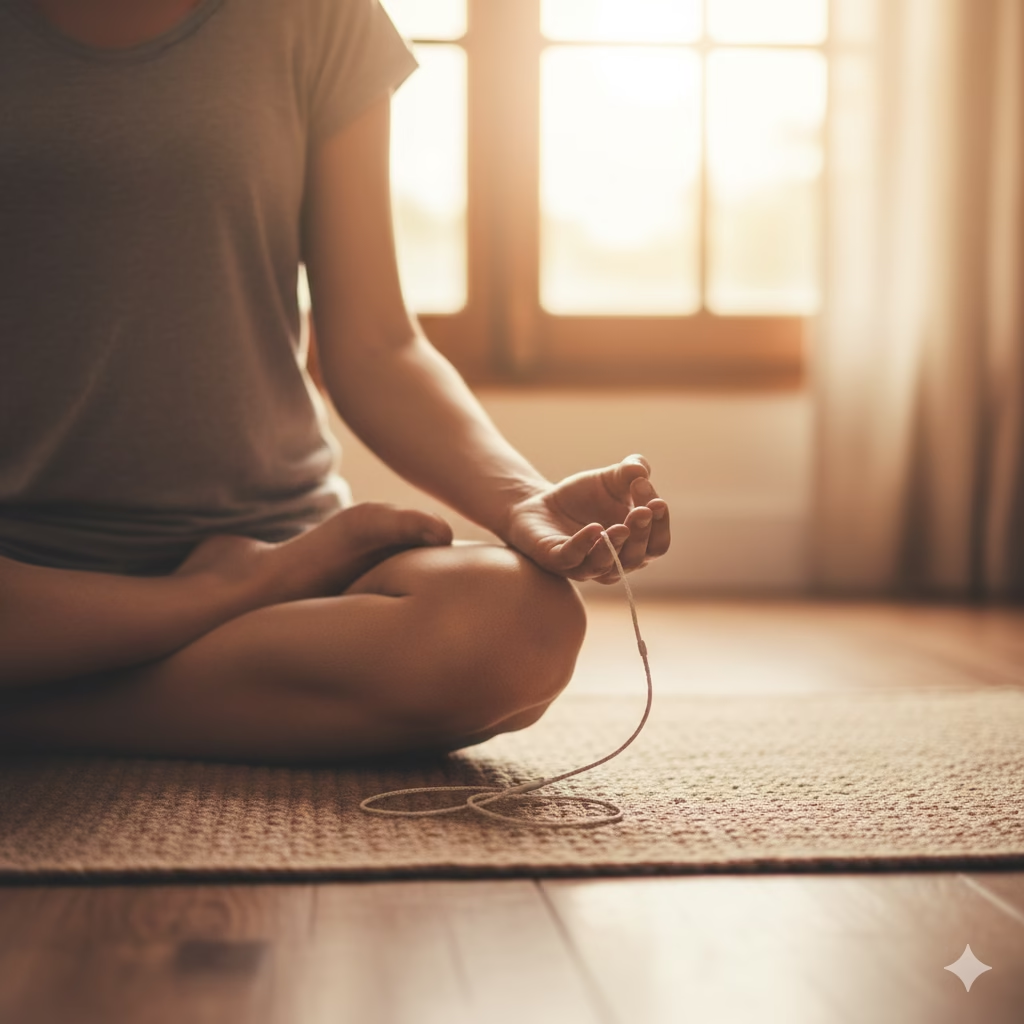
We’ve all hit that afternoon slump, grabbed another coffee, and ended up with the jitters but no extra focus. I’ve spent countless hours looking for tools to help me concentrate without the caffeine crash. This deep dive into Brown Noise reveals the secret to sustained, calm focus that feels like finding an inner silence.
Brown Noise: The Focus Hack That Went Viral
In the quest for peak productivity, we’ve tried everything: cold showers, fancy supplements, and, of course, endless coffee. But what if the most powerful focus tool isn’t something you consume, but something you simply listen to?
Enter Brown Noise. This sound has exploded across social media and wellness apps, hailed by students, remote workers, and those with ADHD alike. It’s often described as a deeper, richer alternative to the classic white noise. But calling it “the new coffee” is more than just a catchy phrase. Brown Noise doesn’t inject energy; it clears the fog, calms the jitters, and builds a solid foundation for deep, sustained focus.
But what exactly is Brown Noise? How does this low, rumbling sound manage to silence mental chatter better than a double espresso? We’re diving deep into the science and practical application of the most powerful sonic tool in your wellness toolkit.
What is Brown Noise? Deconstructing the Noise Color Spectrum

To understand why Brown Noise works so well, we first need to understand where it sits on the spectrum of “colored noise.” These colors aren’t about light; they are a way to categorize sounds based on their frequency distribution—meaning which pitches carry the most energy.
A. White Noise: The Jack-of-All-Frequencies
White Noise is the most famous. It contains all audible frequencies at an equal volume. Think of it as static on an old television or the sound of a hissing radiator.
- Pro: It’s great at sound masking because it covers the whole audio spectrum.
- Con: Many people find it harsh, buzzy, or high-pitched, which can be irritating over long periods.
B. Pink Noise: The Natural Balance
Pink Noise is like a gentle version of white noise. It distributes energy more heavily in the lower frequencies. This creates a deeper, smoother sound that many find more pleasant. Think of steady, heavy rainfall, wind rustling through leaves, or the rhythm of a steady human heartbeat.
- Focus: It’s primarily studied and used for promoting deeper, more stable sleep.
C. Brown Noise: The Deep Rumble that Grounds You
Brown Noise (sometimes called Red Noise) places the vast majority of its energy into the lowest frequencies—the bass end of the spectrum. It’s the deepest and most powerful of the three.
- What it Sounds Like: A low, powerful roar, the rumble of distant thunder, the sound of a strong waterfall, or the deep exhaust hum of an airplane.
- The Focus Benefit: Its deep, rumbling quality effectively dampens high-frequency distractions and creates a feeling of being acoustically “cocooned.” It calms the central nervous system without putting you to sleep.
The Science: Why Brown Noise is Better Than Caffeine for Focus

Coffee stimulates the body, increasing heart rate and adrenaline. Brown Noise works by doing the exact opposite: it calms the mind to improve focus.
1. The Auditory Comfort Blanket
Our brains are programmed to react to sudden changes in sound. A slamming door, a car horn, or even a sudden thought can break concentration. This is your “fight or flight” system kicking in.
Brown Noise is the perfect neutralizer. Its low, consistent hum fills the sound field, masking these sudden environmental “spikes.” The low frequencies are perceived as less jarring and more constant than the sharp, high pitches in white noise. By eliminating the auditory alerts, your brain relaxes, and your mental energy is redirected from vigilance to the task at hand.
2. Calming the Overstimulated Mind

For individuals with highly active minds, such as those with ADHD or generalized anxiety, the brain can struggle to filter out irrelevant stimuli. This makes sustained concentration feel impossible.
Research suggests that consistent auditory input, like Brown Noise, provides a form of gentle auditory stimulation that occupies the brain’s filtering mechanisms. This allows the executive function parts of the brain (responsible for focus and decision-making) to function more efficiently. Instead of the sound being a distraction, it becomes a predictable background texture, helping the brain lock onto the task. It’s like turning down the volume on your internal noise and turning up the volume on your task.
3. Lowering Cortisol and Anxiety
Unlike caffeine, which spikes cortisol (your stress hormone), the calming effect of low-frequency Brown Noise helps reduce stress. When your nervous system isn’t constantly on high alert, your body’s stress response decreases. This physical state of calm is critical for the type of deep work that requires concentration, memory, and analytical thinking—activities coffee often makes jumpy, but Brown Noise makes smooth.
Brown Noise in Practice: Your Productivity Playbook
Ready to swap your third cup of coffee for this low-frequency focus tool? Here is your guide to using Brown Noise for maximum mental clarity.
A. The Focus Zone: Deep Work Sessions

Goal: Sustained concentration and blocking distracting voices or external noise.
- How to Use: Play Brown Noise at a low, steady volume that is just loud enough to mask nearby human voices or keyboard clicking. Avoid using music with it, as that provides a rhythm that can be distracting.
- Best Time: Ideal for the “deep work” block (e.g., coding, writing, studying complex material) or that post-lunch slump when your energy naturally dips.
- Tip: Experiment with the depth. Some apps allow you to adjust the “darkness” of the Brown Noise. A deeper rumble is often more effective for focus.
B. The Anti-Anxiety Shield: Calming the Jitters

Goal: Reducing internal anxiety, preventing racing thoughts, and maintaining mental equilibrium.
- How to Use: Listen to Brown Noise through headphones during stressful moments or when starting a daunting task. The headphone use intensifies the grounding sensation.
- Best Time: Use it 10-15 minutes before a presentation, a difficult meeting, or an intense planning session. It helps preemptively calm the nervous system.
- Tip: Combine it with a simple breathing exercise: listen to the rumble, and try to match the rhythm of your deep exhale to the sustained sound.
C. The Wind-Down: Trading Jitters for Sleep
While Pink Noise is often cited for sleep, Brown Noise excels at turning off the “thinking mind,” making it an incredible asset for falling asleep when anxiety or mental hyperactivity is the problem.
- How to Use: Set a timer and play the Brown Noise through a speaker in your room (not headphones, as they can be uncomfortable all night). Keep the volume low.
- Best Time: Play it for at least 30 minutes during your wind-down routine (reading, stretching, no screens).
- Tip: If you wake up in the middle of the night, turning the Brown Noise back on can quickly stop the mind from racing and pull you back into sleep.
Troubleshooting: Getting the Most From Your Brown Noise

If you’ve tried Brown Noise and didn’t feel an effect, the issue might be in the application. Follow these best practices to ensure success.
1. Volume is Everything
The mistake most users make is playing the noise too loudly. It should not be distracting or overwhelming. It needs to be just loud enough to act as a sonic filter—that’s the sweet spot. If you can hear the sound and the background distractions, turn it up slightly. If the sound itself is bothering you, turn it down. Never blast it, especially when using headphones.
2. Headphones vs. Speakers
- For Focus/Study: Use headphones. This creates a private, sealed environment where the masking effect is maximized.
- For Sleep/Ambient Calm: Use a good quality speaker placed a few feet away. This allows the sound to fill the room naturally and creates a less intense experience for the nervous system.
3. Avoid Mixing Sounds
When first experimenting with Brown Noise for focus, avoid mixing it with music (even instrumental or ambient tracks). Your brain will try to process two different types of input, which defeats the purpose of the single, consistent focus tool. Once you are comfortable, you may find that light instrumental tracks can be added, but always start with the pure noise.
4. It’s a Tool, Not a Cure
Brown Noise is a powerful productivity tool, but it’s not a substitute for core wellness habits. It won’t work miracles if you are severely sleep-deprived, malnourished, or overly stressed. Think of it as the ultimate accelerator for existing healthy habits, not a complete replacement for the mental clarity you gain from breaks and good nutrition. It enhances your current state of calm; it doesn’t create it from scratch.
Conclusion: Trading Brown Noise for Deep Focus

The popularity of Brown Noise marks a shift in how we approach focus and energy. We are moving away from external, stimulating fixes (like coffee and energy drinks) and towards internal regulation through simple, accessible tools.
Brown Noise is the ultimate digital detox for your ears. By providing your brain with a low, consistent rumble, you are effectively giving it permission to stop listening for threats and to finally settle down. It’s a sustainable, side-effect-free way to silence the noise, conquer distractions, and achieve the deep, calm focus you need to excel. Try swapping your next afternoon caffeine hit for thirty minutes of Brown Noise—your brain will thank you for the smooth, focused clarity.
References:
- WebMD – Binaural Beats: What Are They and What Are the Benefits?
- NIH – Pink noise
- Health Harvard – Can white noise really help you sleep better?
Recent Posts


